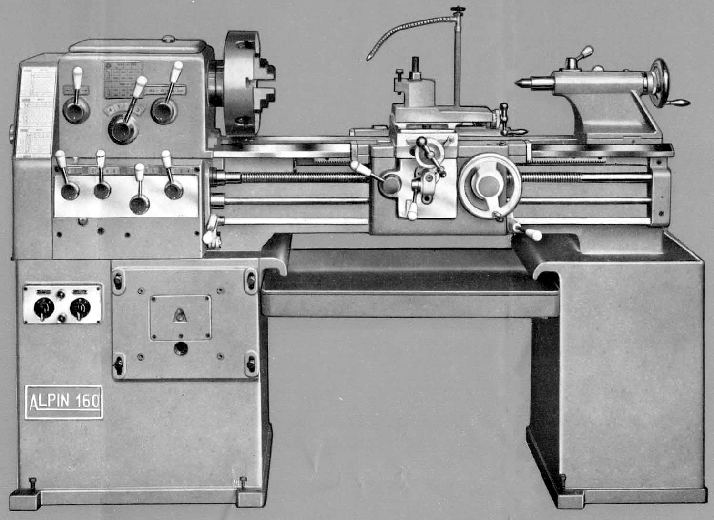|
Alpin lathes (also written as "Al.Pin") were manufactured by OMAP (Office Meccaniche Alberto Pinchiroli) with an address listed as: San Giorgio Su Legano via. Magenta, 25 Italy. Details of just three of the more popular machines from the 1950s are available: the Al.Pin 200, Al.Pin 180 and Al.Pin 160 described by their maker as tornio monopuleggia, that is, in American terminology, a "single-pulley engine" lathe. Although all were cosmetically similar - and shared some details of their specification - each was a model in its own right and correctly engineered for its task with non of the heavier castings shared between them.
The Al.Pin 200 was of 200 mm centre height and could be ordered with a either capacity of 1000, 1500 or 2000 mm between centres. The 320 mm wide V-way bed was of deep rectangular section, with almost no cut-away along the bottom edge, made of heat-treated (but not hardened) cast iron and with a ground finish. A gap was provided as standard and allowed work up to 600 mm in diameter and a maximum of 150 mm thick to be carried on the faceplate. The bed was supported on separate, very heavy cast-iron plinths under headstock and tailstock with a slide-out chip tray between them.
For its era the headstock assembly had pleasing, clean lines and held a heat-treated and ground 45 mm bore spindle running on a bronze bush at the front, an adjustable bronze bearing in the centre and a ball race at the rear. The spindle nose, carrying an American Long-nose taper in an L0 size, was, like its bore, rather small for the lathe's size and weight: a larger-diameter spindle with an L1 nose (the next size up) would have been more appropriate as was fitted, for example, to the Colchester Mascot, a contemporary lathe of similar capacity. It is likely, though not confirmed, that early versions of the lathe would have had a screwed spindle nose. The headstock gears were all in heat-treated alloy steel and ran on ball races - the whole assembly positively lubricated by a pumped oil supply. However, the spindle drive was not solely in the headstock, instead the 4-h.p. electric motor was fitted in the base of the headstock-end plinth and drove, by 3 V-belts and a double, multi-plate clutch, to a speed-change gearbox with oil-bath lubrication and hardened gears running on ball-bearing supported shafts. One of the clutches was used for forward rotation and the other reverse. From the gearbox the drive to the spindle gearing was by 4 V-belts - this combination of drives resulting in a generous set of 16 speeds that spanned a very useful 25 to 1500 rpm. Electrical start, stop and reverse was under the control of a "third shaft" control rod parallel to and below the power-feeds drive shaft. This could be operated by a handle next to the screwcutting gearbox or one pivoting from the right-hand wall of the apron where, because it moved with the carriage, was always within easy reach an operator in his normal working position.
Operated by a row of just four levers on its front face, the screwcutting and feeds gearbox lacked the usual sliding tumbler lever working across an open slot and so was able to be fully enclosed; it ran in an oil bath and was free from the ingress of swarf and dirt. Strangely, even for markets that were fully metric, the 35 mm diameter leadscrew was of 4 t.p.i (4 filetti per pollice) with the screwcutting gearbox able to generate 24 English, 19 metric and 13 module pitches - with each set being obtained by changing just one or two of the drive-train gears. With the standard changewheels in place 12 longitudinal feeds from 0.075 to 0.7 mm and 12 cross feeds from 0.09 to 0.35 mm were available - all per one revolution of the spindle. The leadscrew drive could be uncoupled from the gearbox and so was required to run only when cutting threads.
Deep and strongly built the apron was doubled walled with all shafts supported at both ends and fitted with a lever-operated clutch to both select and engage the power sliding and surfacing motions.
Heavily constructed, the No. 3 Morse taper tailstock was designed with a casting that allowed a close approach to the headstock - yet with enough room for the carriage to work on very short between-centres' jobs. Locked to the bed by a captive lever working through an eccentric cross shaft it did look rather old fashioned in comparison with the rest of the lathe.
The Al.Pin 200 was delivered complete with a motor and switchgear, spanners, a 0.25 h.p. coolant pump with distribution pipes and tank, a 350 mm diameter combined faceplate and light-duty 4-jaw chuck with hardened jaws (a popular and inexpensive-to-supply fitting at the time), a drive plate, a 250mm diameter backplate intended for the mounting of a 3-jaw chuck, a fixed steady, travelling steady, a headstock spindle adaptor to reduce the bore from a No. 5 Morse to a No. 4 and two ordinary hard centres..
|
|





